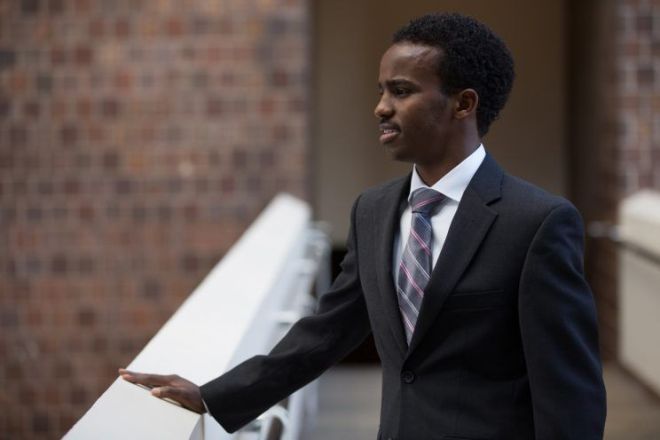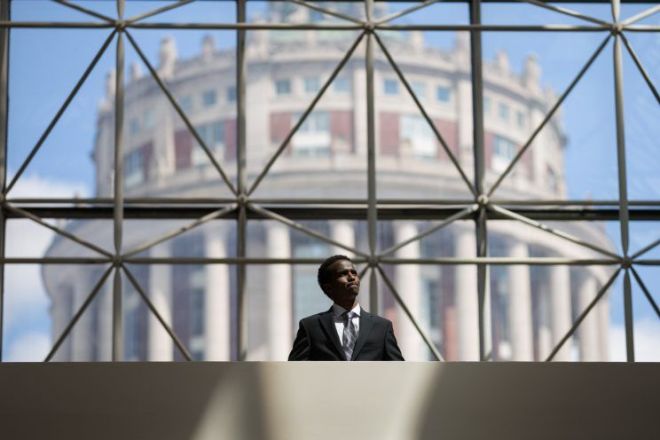
Wednesday June 28, 2017

Earlier this year, Mustapha Ibrahim, a freshman at the University of Rochester in New York, had been planning to celebrate the end of Ramadan last weekend with his family in Somalia.
Ibrahim had intended to return home over the summer after he finished his first year of school in the U.S., which also marked the first time he’d set foot in America.
Instead, the 20-year-old is spending his summer break on campus. He’s one of thousands of international students whose summer plans were put in limbo earlier this year by two successive executive orders prohibiting entry into the U.S. by citizens of several Muslim-majority countries for 90 days.
Since the orders were issued, universities have been on the frontlines of the fight against them. They’ve stood up for their students and faculty from the countries listed in the orders, opposing the bans with protests and statements in the courts, and with advice and workshops with immigration lawyers.
After federal judges blocked the nationwide enactment of the first ban and then of its successor, the U.S. Supreme Court announced Monday that it will hear arguments in the case this October. In the meantime, the justices upheld the ban for foreigners who have no relationship to the U.S. and who have not previously visited the country. Those with ties to America, presumably including students at American colleges, will be allowed in, for now.
“Today’s unanimous Supreme Court decision is a clear victory for our national security. It allows the travel suspension for the six terror-prone countries and the refugee suspension to become largely effective,” President Trump wrote in a statement Monday.
Federal courts had previously ruled that the travel bans had violated the First Amendment, and that Trump had overstepped his authority as president.
But even while the orders were entirely halted by the courts, students felt threatened by the possibility of delays at customs, detention at airports or rejected visa applications. And there were concerns that a future executive order could bar them from the country, leaving them stranded and unable to complete their schooling.
More than one million international students study in the U.S. According to 2015 data from the Department of Homeland Security, there are 23,763 international students in the U.S. who would have been affected by the first version of the travel ban, which shut out citizens from Iran, Iraq, Libya, Somalia, Sudan, Syria and Yemen. The revised ban, which does not apply to citizens of Iraq, would have affected 22,688 students, according to the 2015 data.

More than 50 university presidents, including all of those of the Ivy League, signed a February letter calling on Trump to “rectify or rescind” the first executive order. The American Association of University Professors, which represents professors at more than 500 campuses nationwide, condemned both travel bans, calling the first executive order “unconstitutional and discriminatory.”
“When you ban people, you threaten academic freedom,” the AAUP wrote in response to the second order.
Rutgers University anthropology professor David Hughes said he’s only seen this level of activism on campuses during anti-apartheid demonstrations in the mid-1980s.
“Trump’s policies are an existential threat to our learning environment,” Hughes said, explaining that faculty members felt obligated to take action against the executive orders.
“We have long-term responsibilities,” Hughes said. “It takes six years or so to get a degree. We like to advise and mentor students that go well beyond the classroom or semester. … Trump’s policies were going to divide us from our responsibilities and our duties. We said
Trump could only get to these students by going through us and we were not going to let him get through us.”
After the initial protests and statements, universities took to the courts. In the first months of the legal battle against the bans, more than 30 universities — including all eight Ivy League institutions — jointly filed amicus curiae briefs against both of the executive orders in court. Though the universities are not involved directly with any of the lawsuits, the intent behind an amicus brief is to influence the court’s decision.
“The Executive Order has serious and chilling implications for amici’s students, faculty, and scholars,” a March 31 brief filed against the second executive order reads. “[The order] impairs the ability of American universities to draw the finest international talent, and inhibits the free exchange of ideas.”
For international students, the travel bans prompted many to remain in the U.S. over the summer rather than face the potentially arduous task of reentry.
“Their families would be calling them and telling them we don’t want you to come home because we don’t want to risk this opportunity for you,” said Molly Jolliff, director of international student engagement at the University of Rochester.
Several institutions have stepped in to help international students, offering free or subsidized housing, helping students find summer jobs or arranging summer classes. Those schools include Ithaca College in New York and Ohio University, which have provided housing to students. Northeastern University, in Boston, which has about 250 international students, advised its students to remain in the U.S. over the summer.
Arrangements to help students at the University of Rochester have become so comprehensive that the school has jokingly started to refer to the arrangements as “ban camp,” Jolliff said. But it’s more accurately described as a support program for students trying to do what they came to the U.S. to do: gain skills and a degree.
As Jolliff continued to work with students affected by the bans, she realized that summer brought Ramadan, a month-long holiday of fasting and prayer for Muslims. During Ramadan, Muslims fast from dawn until sunset — but dining areas on the University of Rochester’s campus weren’t necessarily open when Muslim students could eat.

So Jolliff brought them fridges, which allowed the students to store food and eat on their own schedule.
“We wanted to make sure if we were supporting them to stay here that they were well taken care of,” she said. “I just saw a student posting [on social media] this week, because it is Ramadan, and they were expecting to be home with their family, that the political climate is not warm and welcoming to them, so they’re feeling isolated. They didn’t expect this level of uncertainty, scrutiny [or] risk.”
“It has been a really tough time not being able to go home and see family,” Ibrahim said. But he knows he probably won’t be able to return home until 2018, since he doesn’t want to risk rejection of his visa application for reentry, especially in this uncertain political climate.
The travel bans have caused some other international students to question whether they should attend U.S. institutions in the fall, with nearly 40 percent of colleges reporting an overall decrease in applications from international students this year compared to the previous year, according to a survey of more than 275 colleges by the American Association of Collegiate Registrars and Admissions Officers. Applications from students in the Middle East have been particularly affected. But 35 percent of schools reported an increase in international student applications, suggesting it’s too early to conclude that there’s a “definite decline” in international student enrollment. The report concluded that the data do suggest an “early-warning sign of potential declines.”
After the 2016 election cycle, Joseph Helble, dean of the Thayer School of Engineering at Dartmouth College, began noticing “substantial declines” in the number of international graduate student applications. He contacted more than 25 deans at other engineering schools, who reported similar declines in applications.
“We’ve not seen a situation like this in my 20-plus years as an academic, when international applications have declined dramatically, other than in the immediate aftermath of 9/11,” Helble said.
The dean knew that he had to do something to retain the international students who had been offered admission, so he recruited faculty and students to engage with admitted students and reassure them that they’re welcome at a U.S. institution.
“You are the world’s best and brightest,” Helble tells them. He noted that he won’t have comprehensive data about whether those retention efforts have been successful until the fall semester, when students arrive on campus.
Because the composition of engineering programs tends to be heavily international, they can more accurately reflect trends on how international students view education in the U.S., Helble said.
The Dartmouth engineering dean remains optimistic about the short-term effects — noting that he thinks the yield of accepted students who choose to attend his program will remain the same as in previous years. But he’s worried about the potential long-term effects, noting that it’s not just about colleges, but about the U.S. economy.
“Engineering, science, STEM grad students are the next generation of tech developers [and] leaders,” Helble said. “If we cut that talent out, we’re starting far fewer companies, not offering economic growth opportunities.”
Even before they enter the workforce, international students contribute to the U.S. economy. In the 2015–2016 academic year, students added about $32.8 billion to the economy by spending money to support themselves during their education, according to a study by the nonprofit group NAFSA: Association of International Educators. Their presence helps support more than 400,000 jobs in the U.S. economy — such as those in higher education and transportation.
Ali Khaledi, a graduate student at Ohio University, had planned to build a life in the U.S. after completing a doctorate in physics. But with the introduction of the travel ban and an increasingly volatile political climate, he’s wondering whether he should pursue opportunities abroad instead.
“There’s a cloud of uncertainty above my career,” Khaledi said. “When I came to the U.S., I was planning on staying here, doing research, having a family at some point. Now I’m really wondering [if] this is a place that I want to be.”
Khaledi pointed to a shooting earlier this year in Kansas, where an Indian man was shot and killed in a bar because the shooter believed he was Iranian.
“These types of incidents make me wonder,” Khaledi said. “I changed my lifestyle, I try to avoid going places that I can’t see a lot of international students because I am afraid. What if they don’t like the way I look?”
One of Khaledi’s friends, a doctoral candidate from Iran, left the country to visit home despite his fear that he won’t be allowed back in. His father has had two surgeries, and it might be the last time he is able to see him. Even though his family downplayed his father’s condition and urged him to stay in the U.S., Khaledi said his friend is still choosing to return home.
Khaledi and Ibrahim both affirmed that international students endure emotional and mental strain from the executive orders and the worry over whether to stay in the U.S.
“When I was making the decision to stay here for the summer, … I felt like I had to make the decision between either going back home and might not be able to come back in for an education or not going back home and just abandoning family and continuing education,” Ibrahim said. “I still feel guilty about that. … it’s something that’s always on my mind.”
But Ibrahim remains optimistic about his plans to return to his family, at the latest after his college graduation.
“I know no matter what happens, I’m going back home,” Ibrahim said.